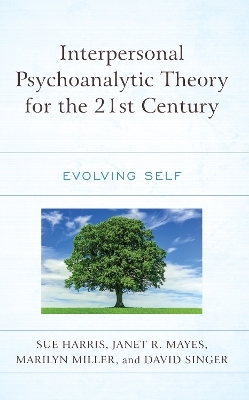
Interpersonal Psychoanalytic Theory for the 21st Century
Lexington Books/Fortress Academic (Verlag)
978-1-6669-2750-4 (ISBN)
Interpersonal psychoanalytic theory states that people can achieve insight into how, through interactions with people, they became who they are, and how they can change patterns of living that limit further satisfaction. People are born with a blueprint for growth and development that includes self-respect, joy, expansion of experiences, creativity, and ever widening and deepening human interactions. With some exceptions, the mental health profession in the United States is dictated by insurance and pharmaceutical companies, focusing primarily on symptom reduction and social conformity. These goals are inadequate. The goal, as elucidated in this book, is maximizing one's human potential. Interpersonal Psychoanalytic Theory for the 21st Century: Evolving Self is written for practitioners in all areas of mental health and pedagogy, whether or not they are psychotherapists or clinicians. It is also intended for anyone interested in understanding themselves and other people. Additionally, in the spirit of Harry Stack Sullivan, developer of the theory, this volume addresses some pressing issues relevant to interpersonal theory and practice in the twenty-first century social/economic/political milieu.
Sue Harris has been in private practice in New York City since 1968. Janet R. Mayes was in private practice in New York City and was an adjunct lecturer of psychology at various colleges and universities, including Montclair State University and Kene University. Marilyn Miller (1939-2020) was a certified clinical nurse specialist in adult psychiatric and mental health nursing in addition to her private practice in New York City. David Singer has his private practice in New York City and serves as clinical psychologist at Abbott House and as adjunct assistant professor at John Jay College for Criminal Justice.
Preface
Acknowledgments
Introduction
Chapter One: Basic Concepts
I. Developmental Eras
Chapter Two: Early Infancy: The Development of Initial Blueprints for Later Experience
Chapter Three: Late Infancy: Exploring Beyond the Self
Chapter Four: Childhood: The Widening World
Chapter: Five: The Juvenile Era: Group Experience and The Political Arts of Relating
Chapter Six: Preadolescence: Falling in Love with a Peer
Chapter Seven: Adolescence: Precursor to Independence, Emergence of Sexuality, Need for Partnership, Intimacy—A Work in Progress
Chapter Eight: Adulthood: A New Interpersonal Challenge
II. Personality and How It Works
Chapter Nine: The Self-system
Chapter Ten: Despair and the Central Paranoia
Chapter Eleven: Cognitive Development, an Interpersonal Phenomenon
Chapter Twelve: The (Essential) Interpersonal Context of Learning
Chapter Thirteen: The Interpersonal Theory of Envy
III. Practical Applications
Chapter Fourteen: Interpersonal Theory and Psychotherapy
Chapter Fifteen: Dreams: Their Origin, Development and Use in Therapy
IV. Issues
Chapter Sixteen: LGBTQIA+ Issues and Interpersonal Theory
Chapter Seventeen: The Current Context Of “Mental Disorders,” “Diagnosis” And their Treatment
Chapter Eighteen: The Political Economy of Psychotherapy
Chapter Nineteen: A Comparison of Revolutionary and Interpersonal Theories
Bibliography
Index
About the Authors
| Erscheinungsdatum | 13.01.2023 |
|---|---|
| Sprache | englisch |
| Maße | 159 x 238 mm |
| Gewicht | 635 g |
| Themenwelt | Geisteswissenschaften ► Psychologie ► Entwicklungspsychologie |
| Geisteswissenschaften ► Psychologie ► Psychoanalyse / Tiefenpsychologie | |
| Sozialwissenschaften ► Soziologie | |
| ISBN-10 | 1-6669-2750-3 / 1666927503 |
| ISBN-13 | 978-1-6669-2750-4 / 9781666927504 |
| Zustand | Neuware |
| Haben Sie eine Frage zum Produkt? |
aus dem Bereich


